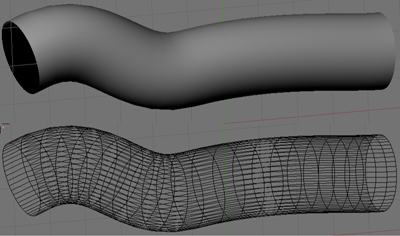Define a circle as a geometric circle of positive, finite radius: a set of points in $\mathbb{R}^3$ congruent to the set $x^2 + y^2 = r^2$ in the $xy$-plane. [Edited as per BMann's comment.] I am interested in classifying surfaces $S$ embedded in $\mathbb{R}^3$ in two categories:
- Define $S$ to be a circled surface if every point of $S$ is contained in a circle that lies in $S$. (I choose the name "circled" in analogy with ruled surfaces.) Thus, $S$ is a union of circles; it is covered by circles.
- Define $S$ to be a hoop surface if it may be partitioned into circles, i.e., it is a disjoint union of circles (hoops). In such a partition, every point of $S$ is contained in a unique circle of the partition that lies in $S$. [Edited as per Charles Siegel's comment.]
A specialization would be to restrict the circles in either class to be congruent, unit-radius circles. Generalizations include: (a) relaxing embedded to immersed; (b) replacing circles by spheres in $\mathbb{R}^d$; (c) replacing geometric circles with topological circles.
Setting aside these variants, let me list the hoop surfaces I know:

- Tubular surfaces, topological cylinders, either infinite in both directions, or with a circular boundary at one or both ends. These are sometimes called tubular splines in computer graphics.
- Tubular surfaces capped at either or both ends but with one point missing from the cap.
- Torus surfaces; genus 1.
- Disk-like surfaces (composed of nested circles) with one interior point removed. [Edited as per J.C. Ottem's comment.]
- A surface homemorphic to the plane with one point removed.
- [Due to Cristi Stoica, explained in his answer below.] A surface homeomorphic to two planes connected by a wormhole.
Is this list complete?
Every hoop surface is a circled surface, but planes and spheres are circled surfaces. I cannot see how to form a circled surface of genus greater than 1.
Have these concepts been explored before, and if so, under what names? My searches have been unsuccessful. Thanks for any ideas or literature pointers!
Addendum. The variant of immersed hoops surfaces partitioned into topological circles has been thoroughly analyzed in a paper by Gábor Moussong and Nándor Simányi, "Circle Decompositions of Surfaces":
"The main result in this note is Corollary 3 ... stating that any surface with a circle decomposition is homeomorphic to either a torus, a Klein bottle, an annulus, a Möbius band, an open annulus, a half-open annulus, or an open Möbius band."
